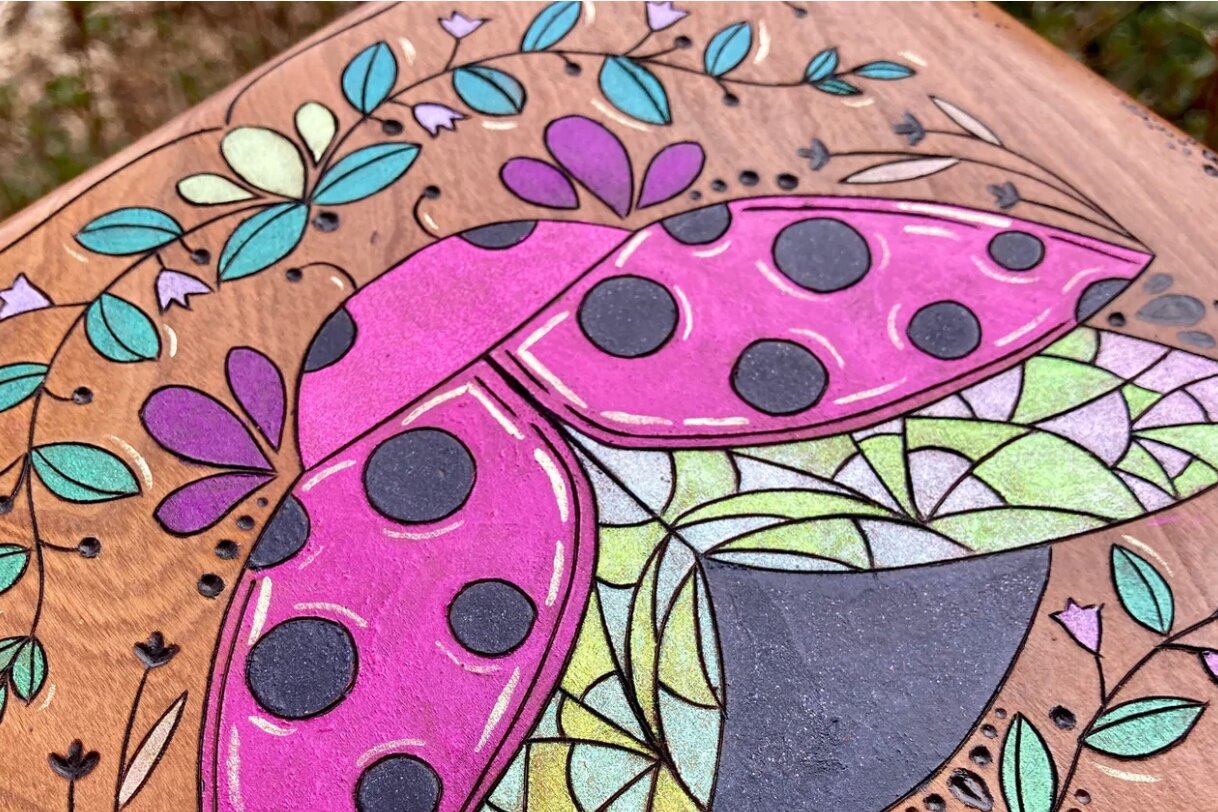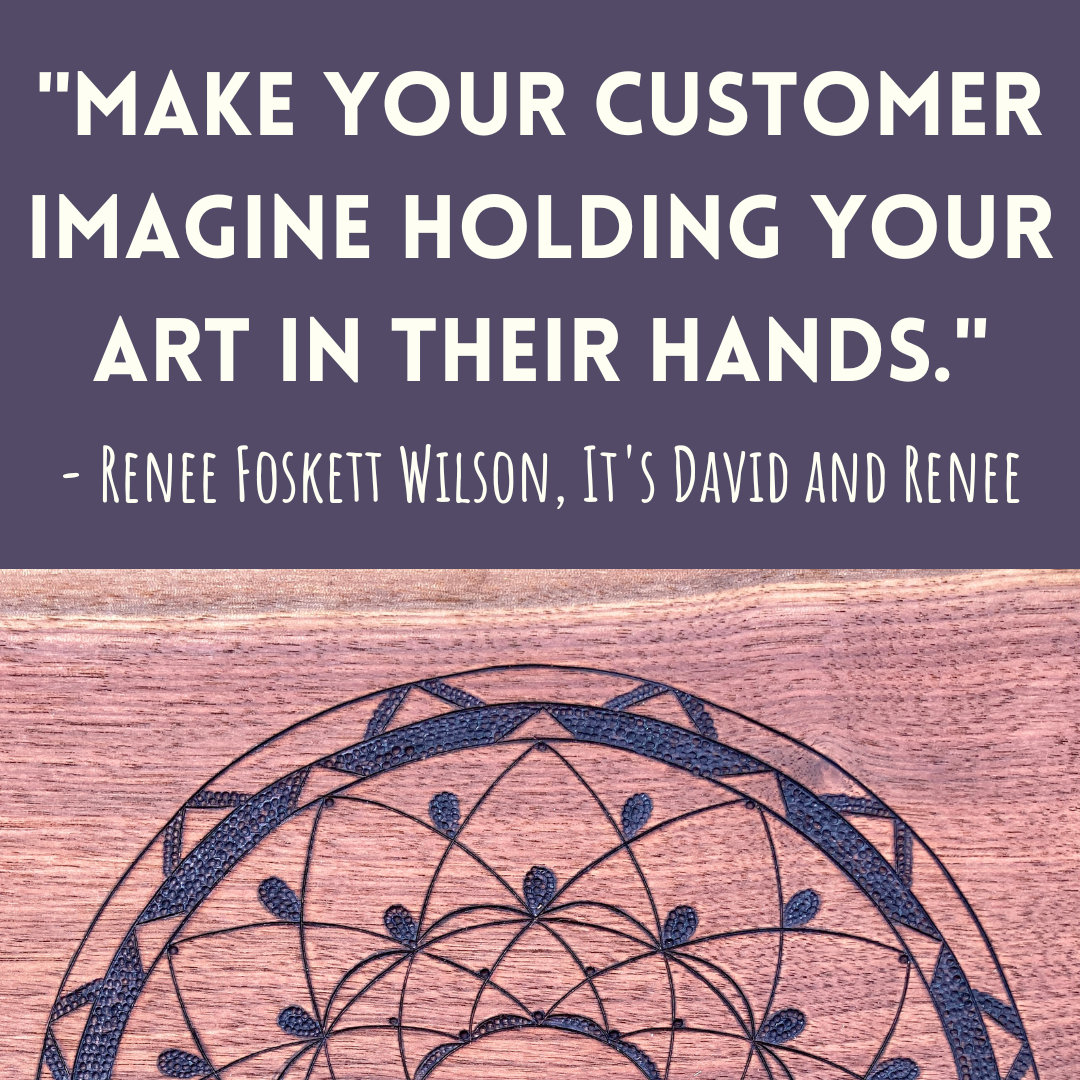David and Renee are the double-duo behind It's David and Renee and specialize in creating sustainably sourced, specialty wood surfaces for other artists to use as a canvas for their own art. They also create thier own fine art pieces, including multi-media pyrography and artisan woodcraft.
Renee of @itsdavidandrenee is such a fabulous pyrographer and person.
Her pyrography is BOLD! Her color choices and sparkle factors alone speak for themselves.
Do yourself a huge favor and follow this wonderful human and artist. Let’s help support her and her husband, David, their art and their delicious wood slice canvases!
Find It’s David and Renee on:
Playing the Name Game with Wood Art: Using the Best Descriptive Words to Elevate You Art in the Mind’s Eye
Guest blog post by Renee of @itsdavidandrenee
So, you’ve made some wood art and now you have to give your piece a name. Whether you’re naming your art based off the subject matter, such as “Whimsical Ladybugs in a Coneflower Garden” or “The Queen’s Crown” or whatever it may be, OR you’re writing a descriptive title of your piece to go into a gallery, there are steps you must take to achieve a solid, effective title that communicates the best properties of your art.
Here are 5 things you should consider when choosing a name for your art:
We’ll dive deep into all five tips below.
Use sensory adjectives
Write as if they already have the art in their hands
Don’t assume they’ll notice the details
Describe the wood canvas, not just the artwork design
Describe the artwork design or subject matter
Use Sensory Adjectives
Sensory words are a MUST! Describing art can be tricky depending on how the art is meant to be consumed. A large art installment full of textiles you can touch and feel is different than a somber war memorial installment, a modern light show, Van Gogh’s Immersive Experiences, or sidewalk chalk art. Even still, those are entirely different than your piece of wood art. Most people are going to be using sight and touch for your wood art, not taste, sound, or smell, so using strong visual sensory adjectives is KEY!
Write as if They Already Have the Art in Their Hands
Pretend someone walks into a gift shop and picks up your artwork to ooo and awe over it! Put yourself in their shoes. What are they looking at? What’s the first thing they notice? How does it feel in their hands? Is it physically smooth? Does it have delicate bark chipping off? Is it a large, heavy wood slice? If they’re looking at it up close and personal, what are they seeing? Are they seeing the crispness of your lines? The glitter, shimmer, and shine of your metallic paint? Are they experiencing the iridescence of holographic foil? Are they embracing the textures of the various fibers in your fiber art? Consider what their “pretend” in-person experience of holding your art is like, and use those descriptors in your online descriptions. Make your customer imagine holding your art in their hands.
Don’t Assume They’ll Notice the Details
Do NOT assume they’ll notice all those above details you worked so hard to achieve. What some people notice, others won’t. Not everyone experiences art the same way. Describe all those details you’re so proud of!
Just like in the above example, you’re going to want to tell them what they’re looking at., even if you think it sounds silly. Example: “When holding this brilliantly vibrant piece in your hands, you’ll notice how the dancing glitter shimmers and shines in the light. The glitter within these paints brings a depth to the pigments that can be truly appreciated when holding this piece at book-reading distance. You’ll also notice the physically indented texture of the woodburned lines and crisp stippled dots when you run your fingers over the textured areas.”
Point out those details! They will appreciate the senses of enjoying your work in person, even if they’re reading your description from the other side of the screen.
Describe the Wood Canvas, Not Just the Artwork Design
Wood canvases are super special and unique, because they themselves have their own characteristics- species, color, shape, thickness, surface texture, grain patterns, smoothness, chatoyance, etc. You should be describing these characteristics and how they play into your artwork, both in your title and in the written description.
People who utilize the standard white canvases from the craft stores usually don’t describe their canvas, because those canvases aren’t unique and don’t play into the effect of the painting. They almost all have the same texture, they all have a wooden frame behind them, and honestly, they’re just plain. Someone can say “canvas,” and you already know what that looks like. It’s already in your mind’s eye. You would just be describing the artwork that you put on the canvas, like “oil painting on canvas” or “fiber art mixed media on canvas.”
But when someone says “wood,” what do you automatically imagine? Rustic basswood? Refined cherry? There are so many varieties and possibilities that it’s guaranteed everyone will imagine something different.
There is a whole world of wood. “Acrylic painting on wood.” What does that tell you? NADA. What kind of wood? Can you even tell your artwork is on wood? Does the wood have live edge bark? Is it a crisp, clean cut piece of wood? GIMME THE DEETS! Is it thick, like ¾”, or is it a thin slice of birch plywood? Your people need to know. Your people should be able to imagine this piece of wood without looking at it.
“Pyrography on wood.”
Absolutely not. Needs waaaayyyy more.
“Pyrography on Maple.”
Nope, still needs more. Describe that Maple.
“Pyrography on an Ambrosia Maple panel.”
More. What does the panel look like? Does it have bark? What shape is it? Is it a round wood slice? Is it a clean-cut panel? More.
“Pyrography on a low-profile, 8” square Ambrosia Maple wood panel.”
Much better! You described the shape, the size, the species, and its side profile (meaning how far it sticks out from the wall).
“Pyrography on a small, round live-edge Basswood wood slice.”
Yep! This is pretty good. Again, you described the shape, the relative size, the species, and its bark features.
I would say those titles are not too wordy but not too stingy on descriptors.
Describe the Artwork Design or Subject Matter
In the above example, we’re using “pyrography,” so let’s continue with that. We need to expand the “pyrography” part of the name. Is your pyro art colored or painted? Is it mixed media? What is an adjective you would use to describe this piece? What is the subject matter of your art? A crazy-colored symmetrical mandala is obviously a way different subject matter than a sepia-toned realistic dog portrait.
*Visually-descriptive adjectives have entered the chat*
Let’s get our list of adjectives out. What does it LOOK like? What kinds of words would you use to describe your art to your grandmother over the phone?
You: “Hi Memaw! Yes ma’am, I’m good. I made some new art. What kind of art? Well, um. It’s woodburned art, I do woodburning.”
Your Memaw: *Doesn’t really know what that means and imagines her living room fireplace with burnt logs.* “Oh, you burn wood? Well that’s… nice.”
This lack of description is confusing to your Memaw. You gotta describe it to her as if you’re in a museum describing it.
When I was in college, I was a professional note-taker for the visually- and hearing-impaired students through the Office of Disabilities. I went to classes that had deaf or blind students, and took notes for them. I got really good at descriptors and adjectives when I was assigned to an art history class and took notes of all the famous art. My visually-impaired clients needed to be able to read my notes out-loud through their computer programs to study later on, so it was my job to make sure I communicated details very effectively. This is the same concept here. Describe your art to someone who is not looking at it.
Here are a few examples:
Vibrant, Dark, Shadowy, Moody, Technicolor, Bright, Playful, Geometric, Detailed, Realistic, Contrasting, Lively, Muted, Monochromatic, Symmetrical, Abstract, Mystical
And the list goes on and on. (This would be a great time to make your own list of adjectives!)
Anyway, back to the example.
We ended #4’s example with “Pyrography on a low-profile, 8” square Ambrosia Maple wood panel.” Let’s use that crazy-colored symmetrical mandala subject matter I mentioned, too. Let’s say the center of the mandala is centered in the middle of the square, and the mandala has vibrant, shimmery pink and purple paints neatly painted in the curves and motifs of the mandala, alternating between the various shades of pinks and purples and radiating out to the edge of the mandala. The negative space around the mandala is just the natural wood with no paint.
To me, in my head, I imagine this piece as very bright, starkly eye-catching, crisp and clean, vibrant and radiant, with even lines, perfectly-spaced swirls and motifs that centrically expand from the center of the mandala. I see these shimmery pink and purple paints catching the sunlight juuuust right, making them seem like they’re glowing from the wood.
“Pyrography on wood” just doesn’t cut it.
“Mandala pyrography.”
Nope. It’s so much more than that. Describe it.
“Symmetrical mandala pyrography.”
Ehh. Closer, but that still isn’t capturing the essence of the piece. DEETS! I NEED THE DEETS!
“Radiant, symmetrical mandala mixed-media pyrography art handburned on a low-profile, 8” square Ambrosia Maple wood panel.”
YES. YESYESYESYES. This is perfect. You have now described the art’s physical appearance (radiant), the subject matter (symmetrical mandala), the media (pyrography and mixed-media), the method of creation (you, “handburned”), the medium (the wood) and the details of the wood.
I would say to follow this Krabby Patty secret formula every time, however, there will always be exceptions to this rule. If you feel like this is too wordy, maybe change out the adjectives to shorten it. If you feel it needs more for your piece, then add a little more.
And remember, if you’re writing a longer description underneath your title or in the description box on your website, you can add more details there. Do what feels right for you and your style of writing, but don’t sell yourself short.
Words are Powerful
To sum it all up, words are powerful. Language evokes the senses. Use your words the best you can to convey the best name, title, and/or description possible.
Make your people envision your art in their head by using sensory words and specific, descriptive adjectives. Put yourself in your customers’ shoes and play pretend. What they notice, feel, see, and experience can be captured in a great description. Play the name game with your wood art. Put just as much effort into naming and describing your art as you did into designing and creating your art. Your website visitors, in-person shoppers, gallery viewers, and whoever else will notice and appreciate these details.







